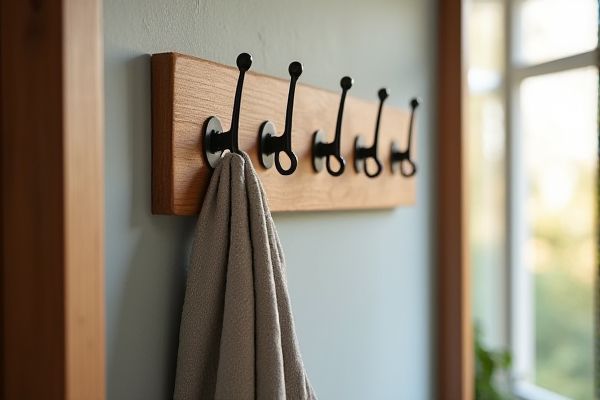
S-hooks provide versatile attachment points with their double curved design, offering secure holds, while J-hooks feature a single curve ideal for quick hanging and easy removal. Explore the differences to determine which hook best suits your needs and enhances your organization system.
Table of Comparison
| Feature | S-Hooks | J-Hooks |
|---|---|---|
| Shape | Double curved "S" shape | Single curved "J" shape |
| Common Uses | Hanging tools, chains, and light objects | Supporting cables, wires, and heavier loads |
| Load Capacity | Moderate load-bearing | Higher load capacity |
| Installation | Easy to install and remove | Requires secure mounting point |
| Material | Steel, stainless steel, or plastic | Steel, stainless steel, or heavy-duty materials |
| Advantages | Versatile and quick use | Strong support and secure hold |
| Disadvantages | Less secure with heavy loads | More complex installation |
Introduction: Understanding S-Hooks and J-Hooks
S-hooks and J-hooks serve critical roles in organization and load distribution in various applications such as cable management and hanging systems. S-hooks feature a double-curved shape that allows for versatile attachment points, providing secure, balanced connections ideal for suspended loads. J-hooks, characterized by a single curved hook shape, offer a straightforward, reliable solution for guiding cables and supporting moderate weights without complex fastening.
Design Differences: S-Hooks vs J-Hooks
S-hooks feature a symmetrical, double-curved design resembling the letter "S," enabling versatile attachment points on both ends for hanging or securing items. In contrast, J-hooks have a single curved end shaped like the letter "J," providing a more secure hold that prevents items from slipping off easily, often used in cable management or hanging systems. The distinct curvature and load distribution of S-hooks versus J-hooks make them suitable for different applications based on the required stability and accessibility.
Common Materials Used for S-Hooks and J-Hooks
S-hooks and J-hooks are commonly crafted from materials such as stainless steel, carbon steel, and aluminum, chosen for their strength and corrosion resistance. Stainless steel S-hooks offer excellent durability and are ideal for outdoor or marine environments, while carbon steel variants often feature protective coatings like zinc plating to prevent rust. Your selection between S-hooks and J-hooks can depend on the specific material properties that best suit the load requirements and environmental conditions of your project.
Strength and Load Capacity Comparison
S-hooks typically offer higher strength and load capacity than J-hooks due to their closed-loop design, which provides better load distribution and reduces the risk of deformation under heavy weights. J-hooks are generally suitable for lighter loads and applications where quick attachment and detachment are needed, but they may bend or fail under excessive stress. Your choice should consider the specific load requirements, as using the correct hook type ensures safety and durability in lifting or securing tasks.
Typical Applications: Where to Use S-Hooks
S-hooks are commonly used in applications requiring easy attachment and detachment, such as hanging kitchen utensils, tools in a workshop, or plants in a garden. Their double curved design allows for quick connections to rods, chains, or wires without the need for additional hardware. Your choice of S-hooks ensures flexibility and convenience in organizing spaces or suspending items securely with minimal effort.
Typical Applications: Where to Use J-Hooks
J-hooks are commonly used in cable management systems to support and route electrical cables, telecommunication wires, and data cables in commercial and residential construction. Their open design allows for easy installation and removal of cables without disturbing the entire setup, making them ideal for maintenance and upgrades. Typical applications include running cables along walls, ceilings, or inside electrical panels where secure but accessible organization is needed.
Installation and Usability Factors
S-hooks offer straightforward installation by simply hooking onto anchor points, requiring no tools and allowing quick adjustments, making them ideal for flexible and temporary setups. J-hooks often require screws or anchors for secure attachment, providing enhanced stability for permanent installations but demanding more precise placement and installation effort. Usability favors S-hooks for versatility and ease of use, while J-hooks excel in holding strength and fixed positioning.
Safety Considerations for S-Hooks and J-Hooks
S-hooks and J-hooks differ in safety due to their structural design, with J-hooks typically offering a more secure fastening by enclosing the load more fully, reducing the risk of accidental disengagement. S-hooks, while versatile and easy to use, can pose greater safety risks because their open-ended shape may allow loads to slip off under certain conditions, particularly if the hook is not properly loaded or if vibrations occur. Selecting the right hook involves assessing load stability, usage environment, and adherence to safety standards to minimize accidents and ensure reliable support.
Cost Differences: S-Hooks vs J-Hooks
S-hooks generally cost less than J-hooks due to their simpler design and widespread availability in various materials like steel and stainless steel. J-hooks, designed for more secure load-bearing applications, often come at a higher price point because of their enhanced safety features and durability. Choosing between S-hooks and J-hooks depends on budget constraints and the specific requirements of the intended use, with S-hooks favored for economical, lighter tasks and J-hooks preferred for heavier, more secure lifting needs.
Choosing the Right Hook for Your Needs
Choosing the right hook depends on your specific application and load requirements, where S-hooks offer quick and versatile connections ideal for hanging items with moderate weight. J-hooks provide enhanced stability and security, making them suitable for heavier loads or permanent fixtures. Understanding the weight capacity and ease of use for your project ensures optimal performance and safety with either hook type.
 homyna.com
homyna.com